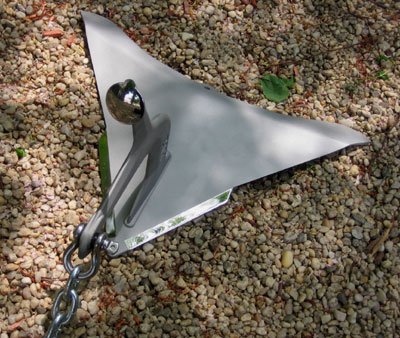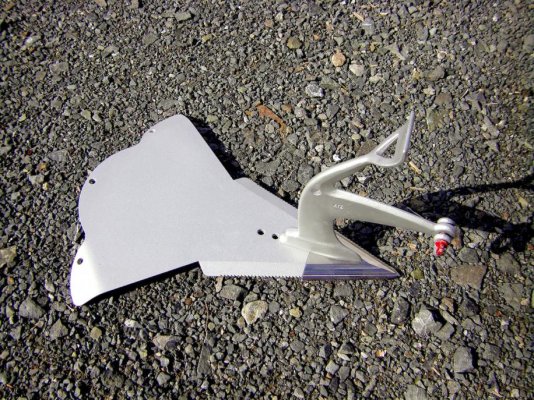Nomad Willy
Guru
Aspect ratios play a major role in the performance of vehicles and other things. Aircraft wings and propellers are a great example. Long skinny wings and propeller blades (all other things remaining equal) have better performance. Canoes and kayaks, being powered by very minimal forces would be very slow if it weren’t for their high aspect ratio hulls.
Does aspect ratio have anything to do w anchor performance? I really don’t know and I think the reasons why AR (aspect ratio) of wings and propellers are very important aren’t the same functionally.
The AR of anchor flukes quite likely a telling thing re performance. The flukes of the highest performance Danforth has a noticeably higher AR than the less expensive versions. No doubt brought about by the higher strength of the forgings and higher carbon steel or similar variables.
The Excel anchor has a high AR fluke. The predecessor to the Excel (the Sarca) is a fairly low AR product. The first XYZ was a very short low AR anchor and the Extreme that followed a high AR. The CQR looks like a high AR anchor but it’s all in the shank length because of the hinge. The Rocna is a relatively high AR anchor but the Vulcan that came after is a short low AR anchor. The Boss and the Supreme are both average in AR and they seem similar in performance too. The Mantus is an interesting study here in that it has both a high AR fluke and a high AR shank.
The shank manipulates the fluke both in pitch and yaw. In pitch under typical tension on the rode their being rather tall and thin perform well under pitch loads. Some anchors (very few) are square or round. Some are tubular thus lighter and stronger like the Spade and Ultra.
During reversals of tidal current or and wind the shank has the responsibility of rotating the fluke, often a difficult task submerged in the seabed. The Danforth and the Mantus appear weak for this maneuver w long skinny shanks and long flukes. One would think the shank would fail. Re the Fortress the shank dosn’t bend because it’s very tapered and made of really strong aluminum (7075 T6 I think). The Mantus is almost certainly steel and not mild steel or we would have heard of many failures (like the Rocna caper) but I have heard nothing so it must be high alloy of some sort.
One anchor manufacturer I’ve spoken w points out that any part of an anchor that is not the fluke should be minimized as the fluke provides the holding power. It’s not that simple but the concept is very valid. The only anchor that has a really small shank that I know of is the XYZ. That’s my storm anchor and has held the boat in at least 50 knot winds. One a 13lb anchor, one 18lbs. So there's little doubt this combination provided high performance. The performance record for this anchor is a black and white affair in that in one anchor test it was clearly #1 in a field of mostly the very best anchors at that time. A mud test. Another XYZ model put up a very poor performance in a European anchor test. A very professional test IMO. I’ve never seen or used this paticular model anchor.
Long shanks and long flukes seem to work well refering to the Excel and Mantus. But long shanks and short anchors seem a good combination. Consider the Boss and the Vulcan.
But setting should get a lot of attention since setting could be the most important element of anchoring. It would be easier to link AR to holding power than setting IMO. So far anchor performance has been this anchor or that anchor is best. More or less some hype and proclamations. Some manufacturers and exuberant users have dominated the noise about what anchor is best. But no real analysis has been made of the elements that make an anchor good or great. Some will be as simple as a sharp fluke tip. Many others are not that obvious. Perhaps some here could offer some insight into what features of an anchor would produce excellent performance. AR is only one variable and frankly I’m having trouble building a case for it. How-a-bout lightness or heavyness? Can someone else come up w other ideas that could lead us to some greater light?
The pics are for those not familiar w the XYZ anchors. The first pic is of the present product called the Extreme. It's as shipped and unmodified.
The second pic is of what I believe to be the first XYZ anchor offered.
Does aspect ratio have anything to do w anchor performance? I really don’t know and I think the reasons why AR (aspect ratio) of wings and propellers are very important aren’t the same functionally.
The AR of anchor flukes quite likely a telling thing re performance. The flukes of the highest performance Danforth has a noticeably higher AR than the less expensive versions. No doubt brought about by the higher strength of the forgings and higher carbon steel or similar variables.
The Excel anchor has a high AR fluke. The predecessor to the Excel (the Sarca) is a fairly low AR product. The first XYZ was a very short low AR anchor and the Extreme that followed a high AR. The CQR looks like a high AR anchor but it’s all in the shank length because of the hinge. The Rocna is a relatively high AR anchor but the Vulcan that came after is a short low AR anchor. The Boss and the Supreme are both average in AR and they seem similar in performance too. The Mantus is an interesting study here in that it has both a high AR fluke and a high AR shank.
The shank manipulates the fluke both in pitch and yaw. In pitch under typical tension on the rode their being rather tall and thin perform well under pitch loads. Some anchors (very few) are square or round. Some are tubular thus lighter and stronger like the Spade and Ultra.
During reversals of tidal current or and wind the shank has the responsibility of rotating the fluke, often a difficult task submerged in the seabed. The Danforth and the Mantus appear weak for this maneuver w long skinny shanks and long flukes. One would think the shank would fail. Re the Fortress the shank dosn’t bend because it’s very tapered and made of really strong aluminum (7075 T6 I think). The Mantus is almost certainly steel and not mild steel or we would have heard of many failures (like the Rocna caper) but I have heard nothing so it must be high alloy of some sort.
One anchor manufacturer I’ve spoken w points out that any part of an anchor that is not the fluke should be minimized as the fluke provides the holding power. It’s not that simple but the concept is very valid. The only anchor that has a really small shank that I know of is the XYZ. That’s my storm anchor and has held the boat in at least 50 knot winds. One a 13lb anchor, one 18lbs. So there's little doubt this combination provided high performance. The performance record for this anchor is a black and white affair in that in one anchor test it was clearly #1 in a field of mostly the very best anchors at that time. A mud test. Another XYZ model put up a very poor performance in a European anchor test. A very professional test IMO. I’ve never seen or used this paticular model anchor.
Long shanks and long flukes seem to work well refering to the Excel and Mantus. But long shanks and short anchors seem a good combination. Consider the Boss and the Vulcan.
But setting should get a lot of attention since setting could be the most important element of anchoring. It would be easier to link AR to holding power than setting IMO. So far anchor performance has been this anchor or that anchor is best. More or less some hype and proclamations. Some manufacturers and exuberant users have dominated the noise about what anchor is best. But no real analysis has been made of the elements that make an anchor good or great. Some will be as simple as a sharp fluke tip. Many others are not that obvious. Perhaps some here could offer some insight into what features of an anchor would produce excellent performance. AR is only one variable and frankly I’m having trouble building a case for it. How-a-bout lightness or heavyness? Can someone else come up w other ideas that could lead us to some greater light?
The pics are for those not familiar w the XYZ anchors. The first pic is of the present product called the Extreme. It's as shipped and unmodified.
The second pic is of what I believe to be the first XYZ anchor offered.
Attachments
Last edited:


